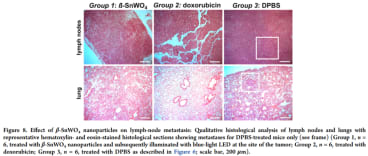Tin Tungstate Nanoparticles β-SnWO4 small molecule (tool compound)
Invented by Claus Feldmann
Invented at Karlsruhe Institute of Technology
- Datasheet
- References (3)
- Inventor Info
Info
| Catalogue Number | 160389 |
| Antigen/Gene or Protein Targets | near-surface tumours |
| Type | Antitumoral |
| Relevance | Tin Tungstate nanoparticles act as photosensitizers for photodynamic tumor therapy of near-surface tumors via reiterated 5 min blue-light LED illumination. |
| In vivo applications | Used to treat tumours in BALB/C mice orthotopically inoculated with the 4T1 breast cancer cell line. Reduced lymph node metastases. |
| In vitro applications | Killed 4T1 cells in vitro. |
| Research Area | Cancer |
| Notes |
"The nanoparticulate inorganic photosensitizer β-SnWO4 is suggested for photodynamic therapy (PDT) of near-surface tumors via reiterated 5 min blue-light LED illumination. β-SnWO4 nanoparticles are obtained via water-based synthesis and comprise excellent colloidal stability under physiological conditions and high biocompatibility at low material complexity. Antitumor and antimetastatic effects were investigated with a spontaneously metastasizing (4T1 cells) orthotopic breast cancer BALB/c mouse model. Besides protamine-functionalized β-SnWO4 (23 mg/kg of body weight, in PBS buffer), chemotherapeutic doxorubicin was used as positive control (2.5 mg/kg of body weight, in PBS buffer) and physiological saline (DPBS) as a negative control. After 21 days, treatment with β-SnWO4 resulted in a clearly inhibited growth of the primary tumor (all tumor volumes below 3 cm3) as compared to the doxorubicin and DPBS control groups (volumes up to 6 cm3). Histological evaluations of lymph nodes and lungs as well as the volume of ipsilateral lymph nodes show a remarkable antimetastatic effect being similar to chemotherapeutic doxorubicin butaccording to blood countsat significantly reduced side effects. On the basis of low material complexity, high cytotoxicity under blue-light LED illumination at low dark and long-term toxicity, β-SnWO4 can be an interesting addition to PDT and the treatment of near-surface tumors, including skin cancer, esophageal/gastric/colon tumors as well as certain types of breast cancer." From Seidl et al 2016, ACS Nano, 10, 3149−3157. |
References: 3 entries
Seidl et al. 2016. ACS Nano. 10(3):3149-57. PMID: 26894966.
Ungelenk et al. 2014. Chem Commun (Camb). 50(50):6600-3. PMID: 24824575.
Ungelenk et al. 2012. Chem Commun (Camb). 48(63):7838-40. PMID: 22735092.
Add a reference
References: 3 entries
Seidl et al. 2016. ACS Nano. 10(3):3149-57. PMID: 26894966.
Ungelenk et al. 2014. Chem Commun (Camb). 50(50):6600-3. PMID: 24824575.
Ungelenk et al. 2012. Chem Commun (Camb). 48(63):7838-40. PMID: 22735092.
Add a reference
Inventor Information
Inventors

|
Claus Feldmann |














